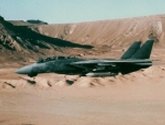
 Flown for
the first time on December 21, 1970 in prototype form, the first
of 478 F-14A aircraft were delivered to the US Navy in October
1972 for operation in September 1974. Despite it's age, the Tomcat
is still one of the most potent interceptors in the world. Boasting
up to six AIM-54C Phoenix AAMs, the F-14A is capable of destroying
six separate targets at ranges in excess of 100 miles. A total
of 79 of the type were exported to Iran. After problems with
the initial TF30 engine, Grumman produced a Tomcat powered by
a pair of GE-400 turbofans. The aircraft became the prototype
for the F-14A+, or later the production F-14B. Test flights improved
model, the F-14D Super Tomcat of which 37 were built, first took
to the air on February 9, 1980 and includes enhanced radar and
cockpit, a dual IRST/TV undernose pod, and increased AAM capability.
Tomcats have later on been equipped for night-attack bombing duty
with the use of LANTIRN (Low Altitude Navigation and Targeting
InfraRed for Night) pods. Placed on an external point beneath
the right wing, the LANTIRN pod allows the F-14 to drop laser-guided
bombs under the cover of darkness.
Flown for
the first time on December 21, 1970 in prototype form, the first
of 478 F-14A aircraft were delivered to the US Navy in October
1972 for operation in September 1974. Despite it's age, the Tomcat
is still one of the most potent interceptors in the world. Boasting
up to six AIM-54C Phoenix AAMs, the F-14A is capable of destroying
six separate targets at ranges in excess of 100 miles. A total
of 79 of the type were exported to Iran. After problems with
the initial TF30 engine, Grumman produced a Tomcat powered by
a pair of GE-400 turbofans. The aircraft became the prototype
for the F-14A+, or later the production F-14B. Test flights improved
model, the F-14D Super Tomcat of which 37 were built, first took
to the air on February 9, 1980 and includes enhanced radar and
cockpit, a dual IRST/TV undernose pod, and increased AAM capability.
Tomcats have later on been equipped for night-attack bombing duty
with the use of LANTIRN (Low Altitude Navigation and Targeting
InfraRed for Night) pods. Placed on an external point beneath
the right wing, the LANTIRN pod allows the F-14 to drop laser-guided
bombs under the cover of darkness.
Nation of Orgin: USA
Constructor: Grumman Aerospace
Type:Strike-Interceptor
Crew: 2
Lenth: 62ft 8in
Height: 16ft
Wing Span: 64.1 feet unswept (20 deg); 38.2 feet swept (68 deg)
Max t-o Weight: 74,349 pounds
Engines: Pratt & Whitney TF30-P-414A afterburning turbofans
Max speed: Mach 2.34
Climg rate: 45,000ft/min
Ceiling: 56,000 ft
Armament: One 20mm M61A-1 Multi-Barrel Cannon with 675 Rounds,
max 8 Missiles in any Permutation; AIM-54 Phoenix, Sparrow and
AIM-9 Sidewinder, free fall and guided bombs.